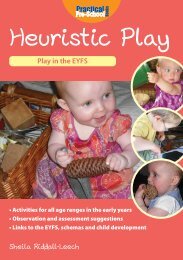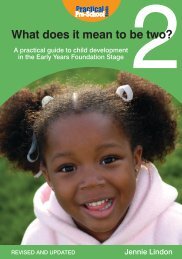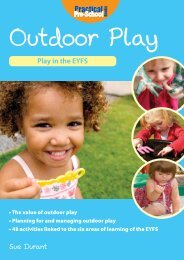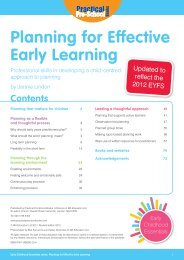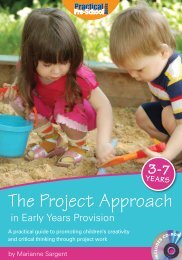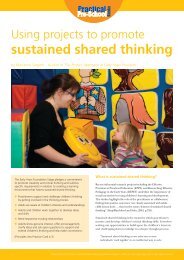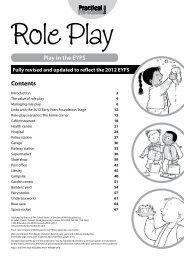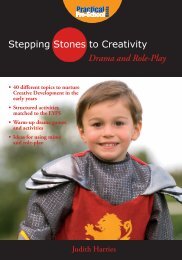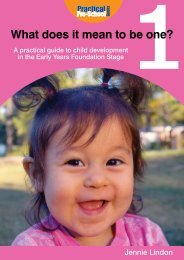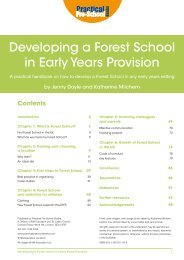Play in the EYFS Contents - Practical Pre-School Books
Play in the EYFS Contents - Practical Pre-School Books
Play in the EYFS Contents - Practical Pre-School Books
You also want an ePaper? Increase the reach of your titles
YUMPU automatically turns print PDFs into web optimized ePapers that Google loves.
Introduc<strong>in</strong>g sensory play<br />
understand snow by actually feel<strong>in</strong>g it <strong>the</strong>mselves. No<br />
amount of stories and pictures will convey its essence or<br />
replace <strong>the</strong> magic of encounter<strong>in</strong>g snow first hand.<br />
Activity<br />
Imag<strong>in</strong>e describ<strong>in</strong>g snow, ice, or couscous to a visitor<br />
from ano<strong>the</strong>r world for whom words have limited<br />
mean<strong>in</strong>g. See how difficult it is to do, how many different<br />
words you need to use and how far <strong>the</strong> visitor is from<br />
understand<strong>in</strong>g <strong>the</strong> sensation of touch<strong>in</strong>g <strong>the</strong>se first-hand.<br />
Tapp<strong>in</strong>g <strong>in</strong>to this amaz<strong>in</strong>g connectivity, richness and<br />
immediacy of thought is key to br<strong>in</strong>g<strong>in</strong>g a curriculum to<br />
life. As we shall discover <strong>in</strong> chapter five, <strong>the</strong> senses can<br />
help make learn<strong>in</strong>g relevant and real. The draft framework<br />
of <strong>the</strong> revised <strong>EYFS</strong> highlights <strong>the</strong> need for explorative<br />
play, active learn<strong>in</strong>g and critical th<strong>in</strong>k<strong>in</strong>g, recognis<strong>in</strong>g <strong>the</strong><br />
importance of “ignit<strong>in</strong>g children’s curiosity and enthusiasm<br />
for learn<strong>in</strong>g, and for build<strong>in</strong>g <strong>the</strong>ir capacity to learn and to<br />
thrive” (Department for Education, July 2011, p.5). Crowe<br />
recognises that “without mean<strong>in</strong>g words are useless ...<br />
words are connectors ... children’s senses cry out to be used<br />
first to provide <strong>the</strong> experiences that <strong>the</strong>y will later need <strong>in</strong><br />
order to connect. Children must feel <strong>the</strong>ir world, listen to it,<br />
see it, taste it, smell it, ‘know’ it...That takes time and a great<br />
deal of silent <strong>in</strong>vestigation <strong>in</strong> peace and privacy” (Brenda<br />
Crowe, 1983, p.39). We return to focussed <strong>in</strong>vestigations <strong>in</strong><br />
chapter three, as children explore unusual natural objects<br />
with sand and water.<br />
Different parts of <strong>the</strong> bra<strong>in</strong> are associated with different<br />
functions and are broadly responsible for process<strong>in</strong>g<br />
different sensory <strong>in</strong>formation from <strong>the</strong> eyes, ears etc. But<br />
as we shall discover <strong>in</strong> chapter two this does not happen<br />
<strong>in</strong> isolation. The bra<strong>in</strong> <strong>in</strong>tegrates all of <strong>the</strong> different pieces<br />
of <strong>in</strong>formation <strong>in</strong> order to make sense of <strong>the</strong> world.<br />
Experiments have shown just how powerful <strong>the</strong> different<br />
senses are <strong>in</strong> ultimately decod<strong>in</strong>g experiences. For example,<br />
Activity<br />
Try <strong>the</strong> experiment opposite yourself by add<strong>in</strong>g food<br />
colour or flavour<strong>in</strong>gs to dr<strong>in</strong>ks to see if it changes o<strong>the</strong>r<br />
people’s perceptions of taste. Always check allergies first.<br />
Sensory <strong>Play</strong> 5




